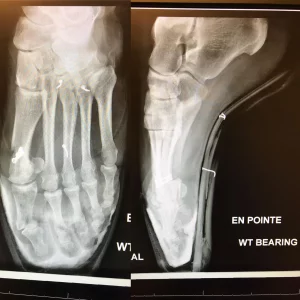In the world of ballet, pointe shoes stand as the quintessential symbol, as iconic as the tutu itself. Although they create an enchanting effect on stage, their preparation and maintenance demand hours of meticulous labor. Paris Opera Ballet’s principal dancer, Valentine Colasante, shared with Agence France Presse (AFP) the unique relationship dancers have with their shoes.
Pointe shoes are constructed from paper and cardboard, materials that require significant care and personalization to perform their function. Currently starring in Tchaikovsky’s “Swan Lake” at the Bastille Opera, Colasante, who has been a principal since 2018, revealed to AFP that she goes through two to three pairs of pointe shoes per performance, a routine that involves regular application of hardening varnish to the soles. “Now, I can prepare my shoes fairly quickly. It’s like tying my hair into a bun – it’s been part of my routine since I was little,” Colasante shared, noting she uses 10 to 15 pairs a month, reusing them for rehearsals but spending about 30 minutes on each pair’s preparation.
To ensure these paper and cardboard shoes properly fit the foot, they must be manually softened—some dancers break, bend, or crush them—trim the sole to enhance the foot’s arch, sew on ribbons and elastics for support, embroider the shoe’s tip for stability, and varnish the sole to extend the shoe’s lifespan. “A well-prepared pair should be able to stand on pointe by itself,” Colasante explained.
Pointe shoes have significantly evolved since their inception in the 19th century, better accommodating the dancer’s foot. Each dancer employs their own methods to protect their feet and prevent blisters. Colasante uses tape and primarily cotton inside her shoes, preferring its ability to mold to the shape of her toes over silicone pads. She believes that, with proper care and acclimation, pointe shoes are less painful than many imagine.
“When I was younger, I danced in harder shoes, but as my feet strengthened, I transitioned to softer pointes. It’s a continuous adjustment process,” Colasante stated, also mentioning her role in advising younger dancers at the dance school. “I’ve always been fascinated by pointe shoes, a feeling that has not faded,” she concluded.
Pointe shoe maintenance is extensive. New pairs are not only expensive but also time-consuming to adapt to one’s feet. Hence, it’s common for dancers to extend each pair’s lifespan as much as possible. However, dancing in broken shoes can significantly increase the risk of various injuries.
Broken pointe shoes, traditionally made from layers of paper, fabric, leather, plastic, cardboard, or burlap hardened with glue, can become less supportive over time. The degradation, accelerated by sweat and wear, can lead to misalignment and, subsequently, long-term issues like bunions, cartilage damage, and other joint problems.
How Can a Worn-Out Ballet Pointe Shoe Cause Injuries?
Dancing en pointe is an unnatural activity for the body. Ballerinas exert four times their body weight onto their feet, necessitating the distribution of forces across the bones and soft tissues as evenly as possible to avoid injury.
The human foot and ankle comprise 26 bones, 33 joints, and more than 100 ligaments and tendons. A well-fitted pointe shoe aids in maintaining the alignment of these structures. However, a “broken” or worn-out shoe can lead to a collapse of these structures onto themselves. This collapse can overload the joints and cause long-term alignment issues such as bunions, cartilage damage leading to arthritis, bone spurs, and a decrease in joint mobility — a condition known as hallux rigidus, which can make dancing on demi-pointe particularly challenging.
When the platform of the shoe softens or the box or shank no longer supports the foot adequately, the dancer’s center of gravity shifts. This shift causes the force to be distributed unevenly across the feet, excessively burdening the forefoot. As the forefoot and the back of the heel start absorbing these forces, the bones of the foot and ankle may be at risk of stress fractures.
Furthermore, various soft tissue injuries can occur as the body attempts to compensate for the misalignment caused by a worn-out shoe. The flexor and extensor tendons of the foot and ankle can become overloaded, attempting to correct this misalignment.
This overcompensation can also cause several muscle groups to work harder than usual, increasing the risk of tendinitis, bursitis, and even tendon tears. While these issues are typically treatable, they can persist even after the damaged shoes are replaced.
Radiographic images of a ballerina’s feet in new pointe shoes (on the left) and old pointe shoes (on the right) clearly show the change in alignment and the collapse of joint spaces due to the lack of support, highlighting the potential for injury.

An X-ray Image of Ballerinas’ Foot in Pointe Shoes:

To prevent injuries, dancers should ensure their shoes fit correctly and replace them regularly, typically every 10 to 20 hours of use, depending on the training intensity. It’s also advised to rotate between multiple pairs to allow them to dry completely and avoid wearing damp shoes.
In summary, while the allure of ballet’s pointe shoes remains timeless, the reality behind their use and care is a complex blend of tradition, personalization, and preventive health measures.
